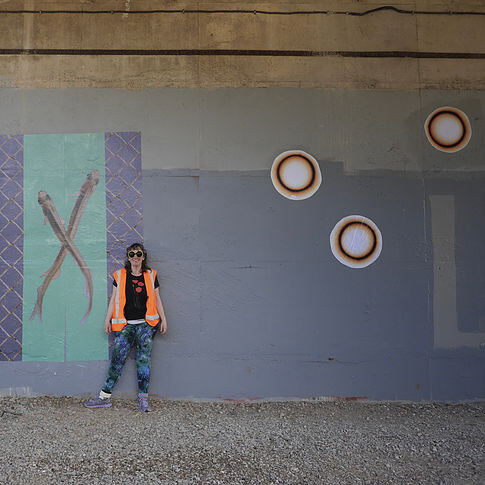Artist exploring nature in the city
 Kedron Parker is a Wellington based artist exploring nature in the city.
Kedron Parker is a Wellington based artist exploring nature in the city.
Her practice is collaborative and includes the audio installation Kumutoto Stream, The Wet Index with Bruce McNaught, the Water Sensitive Urban Design Study Group, Hello Pigeons with Adam Ben-Dror, the Aratoi installation Sanctuary, and the ongoing environmental restoration project Inanga Love Park founded with Paula Warren and Stu Farrant in 2017.
She is currently studying at the Massey University College of Creative Arts (CoCA) to further develop her artwork about Inanga Love Park. The Coastal Restoration Trust has provided a donation of $1000, funded largely through a generous gift from Brew Moon Brewery in Amberley, to support her study and further this work.
Inanga Love Park is a public art installation with an aim of raising awareness about the importance of the ecology of the Korokoro Stream near the foreshore, and the critical role that area plays for our native fish.
Like so many streams across New Zealand, the Korokoro is crossed by roading and transport infrastructure and culverted in its final stretch to the sea, precisely in the area of the salt-water wedge, where native fish including inanga (whitebait) typically breed.
In 2016, Kedron, ecologist Paula Warren, and ecological engineer Stu Farrant came together with curators from the public art organisation Letting Space to rehabilitate this area of the Korokoro, using the tools of art, landscaping and placemaking to create the Inanga Love Park.
Along with a growing list of collaborators, the Inanga Love Park team is looking to “create the conditions for love” and encourage inanga breeding once again in the Korokoro.
It was audacious to call it a “Love Park”. Squeezed between the Petone exit ramp, the motorway and the train tracks, and bordered by industrial development, this stretch of the lower Korokoro was for many years a trashed out gully. This part of the stream was used as a dumping area, full of glass, beer cans, industrial and roading refuse.
With her experience in placemaking and environmental restoration, Paula Warren led a transformation of the site.The stream area has been weeded and planted with natives, the area has been levelled, and rubbish and roading trash hauled away. The surrounding areas, which had been unsightly and dangerous, have now been transformed into a park for people, and a place to visit the stream.
Poster installations interpret the site. It has a rich history, from Maori times through to European settlement.
Inanga Love Park was launched in February 2017 at the Commonground Hutt City Public Art Festival, with a permanent mural by Toothfish, as well as a large poster paste-up about the stream, all visible to those passing the area by foot or by train.
The native grasses and trees on the banks of the stream are looking great. Whitebait Connection has just conducted its second inanga egg hunt with local volunteers - sadly, inanga eggs have yet to be found at the site. Efforts will continue, however, as local interest has blossomed with the Korokoro Environmental Group providing stewardship and a new native garden area adjacent to the site.
The art continues as well - including Parker’s ongoing paste-ups, and a large photographic triptych about her experience at the site which was shown earlier this year in the Shared Lines: Kaikoura Arts Festival and subsequently at the Christchurch Art Centre.
Parker is also collaborating with photographer Victoria Saunders to develop a five minute mini-doco about Liz Mellish and Morrie Love’s experiences and knowledge of the Korokoro Stream, its natural history, the Pa that once stood adjacent to the stream, and the Love Family’s former Marae overlooking the Korokoro.
Inanga Love Park is an example of how art and restoration can work hand-in-hand in engaging communities and enhancing ecological outcomes, especially for non-scenic sensitive environments.
Posted: 18 April 2019 in the News category
